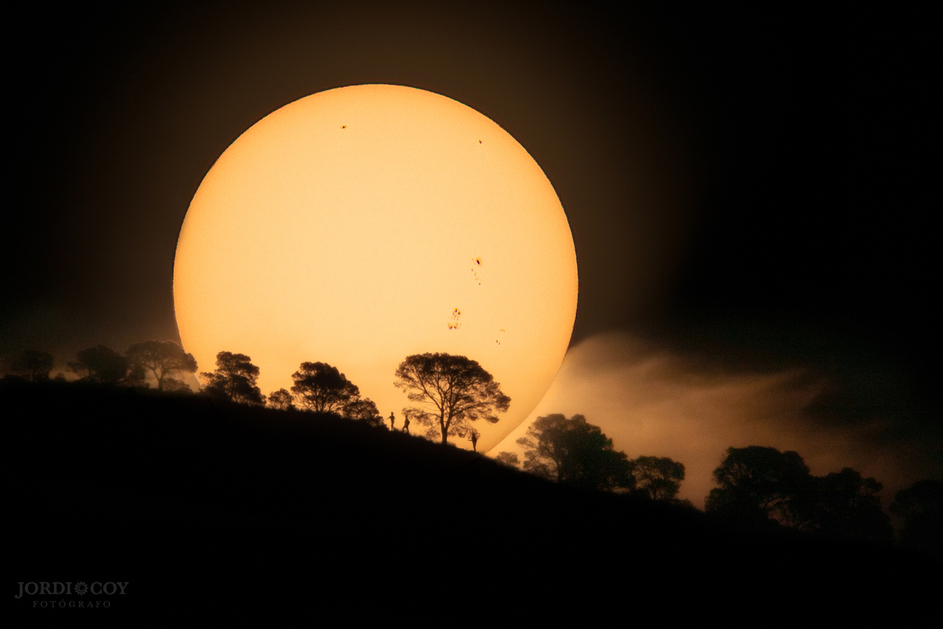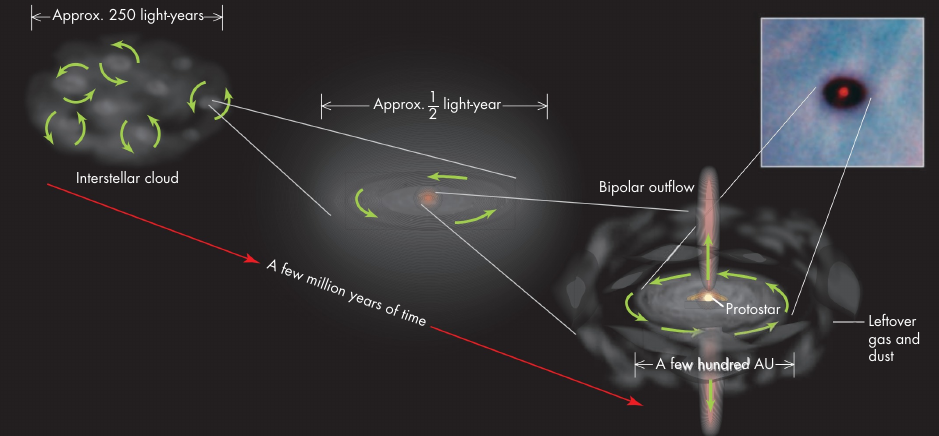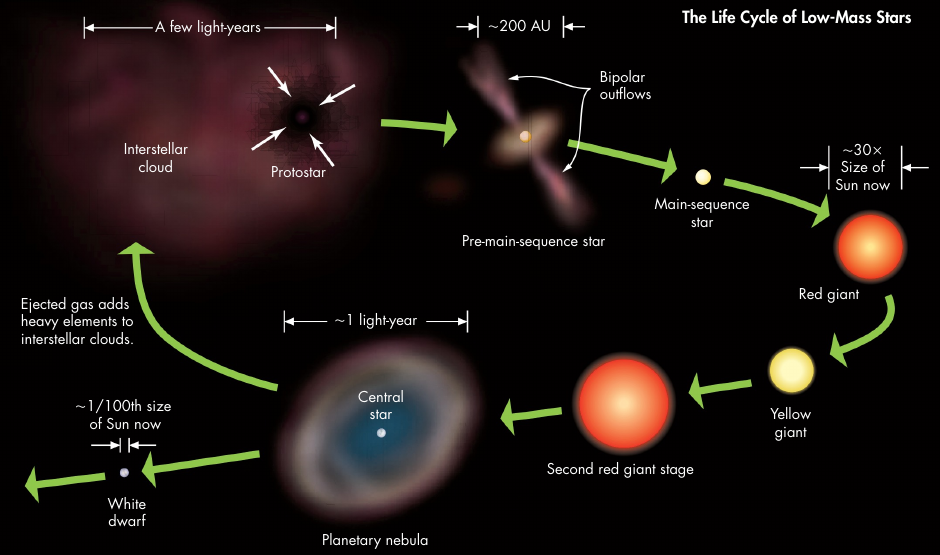Table of Contents
6. Stellar age
We are on an odyssey in time from the big bang to the present allegorically related the course of the Brahmaputra river. Stellar age is the third period in this universal history of seven periods and this age is metaphorically related to the Siang stage of the river. Siang cuts through the largest mountains in the world creating the deepest gorge in the world. This stage is violent and turbulent similar to the creation of stars from giant molecular clouds. In this chapter, we will introduce the structure and evolution of stars within the context of the history of the universe.
1. Stars
We started the galactic age by introducing different types of galaxies. Let us do the same here and get familiarized with different types of stars.

Stars cannot be classified based on their shape because they all have the shape of a sphere as you see in the true-color image of the sun above. Stars are so massive and dense that gravity exerts a huge attractive force and sculpts them into spheres. Remember that gravity is directly proportional to mass and density (from Chapter 2).

Instead stars are classified based on the colors in their light. Different colors correspond to different wavelengths of light. Similar to waves on a ‘field’ of water, light is a wave on the electromagnetic field. The color of light differs according to the wavelength, distance between two crests or troughs as shown above. In the spectrum of light shown there, violet light has short wavelength (400 nm or nano-meter) and red light has large wavelength (665 nm). Let us see how starlight can be used to classify stars.

Different stars radiate most of their light at different wavelengths or colors and they are divided into 7 classes based on their colors. The diagram above shows the spectra (colors of light) of the seven classes named O, B, A, F, G, K and M, from top to bottom. O-type stars are the hottest and the temperature decreases as you descend towards the M-types. If you scrutinize the colors of each class carefully, you will realize that O-type stars have more blue lights than B-types, B-type stars are bluer than A-types, A-type stars have larger blue portion than F-types and so on. M-type stars have very little blue light, they radiate mostly red light. By contrast, F and G type stars radiate mostly in the intermediate yellow-green color. Our sun is a G-type star and, hence, looks yellow-greenish.
The temperatures shown above are the temperatures on the surfaces of stars. A star with a surface temperature of 30,000 degrees is blue, but one with a temperature of 6,000 degrees (like our sun) is yellow-green.
Temperature is directly related to the radius and mass of a star. The star with more mass and larger radius has the higher temperature and vice versa.
2. Interstellar medium
We want to know the origin and evolution of these different types of stars within the context of the history of the universe. For that we need to get an idea of the interstellar medium (ISM), the low-density dilute gas in the almost-empty space between the stars. ISM is important because it is both the birthplace and graveyard of stars.
This medium is so dark and dilute that we cannot see it directly in visible light. But here you see a real recent picture of a patch of the interstellar medium within our Galaxy. This was taken using infrared light. Infrared cameras are used to take photos at night. Everything on the surface of the earth radiates infrared light, so they can be seen with an infrared camera but not with the naked eye. Similarly, the interstellar medium radiates in infrared and it can be visualized using infrared telescopes.
What is this medium made of?
It is made of gas and dust. The gas is mostly made of hydrogen and a bit of helium. Its density is very low, only 1 atom in 1 cubic centimeter. Imagine a cubic region with length, width and height of 1 cm each, close to the size of dice. There is only 1 atom of interstellar gas within such a region. Compare that with the density of air in earth’s atmosphere. There are almost 100 trillion atoms within 1 cubic centimeter of air.
Interstellar dust particles are even more rare. For every trillion atoms of interstellar gas there is only one atom of dust. They are made of chemical elements heavier than helium and are of almost the same size as the domestic dust you see in your house on floors and tables.
Although dust are rare, the interstellar medium is still extremely dusty and dirty, relatively speaking. If you take some interstellar material and compress it to the typical densities of air in the atmosphere, the material will be so dirty that you will not be able to see your own hand in front of you through it. Interstellar medium is almost a million times dirtier (in terms of density) than the atmosphere of earth. Basically, the dust-to-gas ratio is much higher in interstellar space compared to our environment.
Thankfully, the gas and dust are not evenly spread in the ISM, if they were, no stars and planets would form within galaxies. Just as their are high-density clouds in our atmosphere floating the low-density ambient air, so there are large molecular clouds in the ISM floating the relatively low-density medium. These clouds give birth to stars and planets as we will see in the next section.
But how did the light and heavy molecules in the ISM and its clouds get there? We know from the particle age that nothing heavier than hydrogen and helium were produced after the big bang. Where did the other almost 89 heavy molecules of the periodic table come from?
They came from stars themselves. All elements heavier than hydrogen and helium are created inside the cores of stars. This is why I said ISM is both the graveyard and birthplace of stars. Heavy elements are made inside stars, all these elements are scattered in the ISM during the death of stars and, finally, new stars with more heavy elements are formed from the ISM.
3. Star formation
Interstellar molecular clouds are tenuous and cold. There are around 100 atoms in 1 cubic centimeter and their temperature is around $-250$ $^\circ$C.

This diagram shows the formation of stars from such clouds. A large rotating cloud almost 250 light-years (ly) across begins to collapse under its own gravity. During the collapse, it is fragmented into many smaller rotating clouds of around 1 ly size. Each of the smaller clouds collapse as well. Take such a small cloud and see how it gives birth to a star.
The cloud is collapsing, it would contract to a tiny point if nothing opposes the collapse and, in that case, no star would form. Fortunately, there are two outward-pushing effects that can counteract the inward pull of gravity: heat, rotation, magnetism and turbulence.
As the cloud contracts, its temperature increases and the heated gas exerts an outward pressure against gravity. Rotation would be more important in explaining the formation of planetary disks, so we postpone until the next chapter. The effects of magnetism and turbulence are not very prominent, so let us forget about them and stick to the simple scenario where gravity is pulling the cloud inward and gas pressure is pushing it outward. Let us see how this push-pull works out step by step:
- Gravity contracts the small cloud to a size of around 1 ly and the cloud heats up to a temperature of 0 $^\circ$C.
- After a few tens of thousands of years, the size of the cloud is half a ly. Its core is spherical and the periphery is made by a flat disk around the core.
- After a few million years, the core has almost the same size as the orbit of earth around the sun. Temperature in the core is 1 million degrees. The core is now called a protostar. The protostar swallows material from the surrounding disk, uses some of it and ejects the rest through two polar jets, similar to an active galaxy (but of course at a much smaller scale) discussed in the previous chapter.
- The pressure from heated gas is not enough to stabilize a protostar against gravitational contraction. So the protostar contracts more and the temperature of the gas rises.
- When the temperature at the core of the star reaches 10 million degrees, nuclear reaction begins. During the reaction, hydrogen is converted to helium and the resulting energy works with the gas pressure to stabilize the protostar against gravity. This is when the protostar becomes a star.
It is clear that stars are forming from the high-density clouds in the low-density ISM, so ISM must be the birthplace of stars. But why are they graveyards as well? Because all the heavy chemical elements produced inside the core of stars via nuclear reactions are scattered into the ISM after the death of stars. And the dead body itself becomes part of the ISM.
4. Evolution
No new galaxies formed in the last 10 billion years of our history. But stars are forming all the time. Galaxies form and evolve, but until now we have not see any dead galaxy. In contrast, the birth, evolution and death of stars have been observed many times. Stars, like humans, are getting born, evolving and dying all the time. A stellar population size would depend on the rate of birth and death in that region, just like the population of a country.
At the end of the previous section, we saw the birth of stars from protostars. When the outward nuclear radiation pressure and gas pressure balance the inward gravity, stars are born. When the balance is destroyed again, stars begin to die. Compare this with a human being. Our size and mass changes a lot in the first (childhood) and last (old age) stages of life, but we do not change that much in the intermediate middle ages. Similarly, stars change a lot before the onset of nuclear reaction (from cloud to protostar) and after the fuel for nuclear reaction is finished (near the death), but they do not change much in the interim period when stars are well-balanced and middle-aged.
Nothing much happens in a middle-aged star. Hydrogen at the core are steadily converted to helium and the star keeps glowing brightly. But how long this middle age will continue and exactly how the star will spend its last years depend on its mass (and radius). Let us see the life history of low-mass and high-mass stars separately.
4.1 Low-mass stars

The key events in the life of a low-mass star are shown above in 7 convenient stages:
- A protostar forms and heats up because of the contraction of interstellar cloud as described in Section 3.
- The protostar swallows matter and energy from the equatorial disk, uses some part of it and ejects the rest through two polar jets as described before as well.
- The protostar becomes a star when nuclear reaction at its core begins converting hydrogen into helium. As long as there are enough hydrogen at the core, the star is stable and it is called a main-sequence star. Stages 1–2 took around 10 million years, but a main-sequence low-mass star remains stable for 10 billion years.
- When the star runs out of fuel (hydrogen) to burn at its core, outward radiation pressure is turned off and the gas pressure alone cannot resist the inward force of gravity.
- So the star contracts a little and consequently the temperature in a shell surrounding the core reaches 10 million degrees.
- Because of the high temperature the hydrogen in the shell are now converted into helium via nuclear reaction. This is called shell burning as opposed to the previous core burning.
- Compared to the core, the shell is closer to the envelope (outer parts) of a star. Hence, the envelope feels the heat coming out from the shell and begins to expand.
- The star expands a lot and becomes a red giant. (The sun will increase by 30 times its current size and swallow the earth when it becomes a red giant.)
- When all the hydrogen in the shell are finished, the outward radiation pressure stops and the star contracts again because of gravity. This time the temperature at the core reaches 100 million degrees.
- At this extreme temperature, the helium at the core is converted to carbon via nuclear reaction. (When the temperature reached 100 million degrees in the core of a star, carbon was created for the first time in the universe.)
- During this helium core burning, the star is a yellow giant and stable because the outward radiation and gas pressure equal the inward gravity. This stage is somewhat similar to Step 3 above, but helium is burnt instead of hydrogen.
- When a star runs out of helium fuel at the core, all the steps of Stage 4 are repeated (except now it for helium) and this time the star becomes an even bigger red giant.
- Finally, when the star cannot burn helium in the shell surrounding the core anymore, the core collapses because of gravity, similar to Stage 5. The core is now made of carbon converted from helium, but its temperature cannot rise enough to burn carbon. So no more nuclear reaction at the core for the star no matter how much the core contracts.
- Even though the core keeps collapsing, the superhot outer layers of the star expand drastically because of faster-than-normal burning of the good old hydrogen into helium and also the outward pressure of the heated gas.
- The outer envelope is torn apart from the central core and becomes a fuzzy expanding gas called a planetary nebula, even though they have nothing to do with planets.
The fate of the contracting core (a white dwarf) will be discussed in Section 5.
4.2 High-mass stars

The life history of a high-mass star follows the same principles but their final stages are very different. Let us go through the 7 stages of evolution for high-mass star shown above step-by-step:
- An even bigger interstellar cloud (several light years) contracts because of gravity.
- The contracting cloud becomes a protostar that swallows gas from the equatorial disk and ejects bipolar jets.
- When the temperature in the core reaches 10 million degrees, core hydrogen burning begins and we get a main-sequence blue star, blue because it is heavier, hotter and, thereby, emits blue lights most. Low-mass stars remain stable for 10 billion years, but high-mass stars remain in this stage for only 100 million years. The richer runs out of fuel faster.
- When the core runs out of hydrogen to burn, the star contracts and become a pulsating yellow giant. The star keeps contracting because of gravity and expanding because of gas and nuclear pressure.
- When hydrogen in the shell begins to burn, the star expands and becomes a red supergiant, in a process similar to Stage 4 in case of the low-mass stars (Section 4.1).
- When the shell runs out of hydrogen, the star goes back to Stage 4. The temperature in the core increases to 100 million degrees and helium is converted to carbon. After all the helium is converted the star comes back to Stage 5 and burns helium in a shell around carbon.
- When the shell runs out of helium, the star again repeats Stage 4 and 5. The core carbon is converted to oxygen. Carbon, helium and hydrogen layers surround the core.
- This process is repeated and each time a heavier molecule is synthesized via nuclear fusion reaction at the core a star.
- At the end of this process, the core is made of iron and 7 layers surround the core. The layers are made of silicon, magnesium, neon, oxygen, carbon, helium and hydrogen from the center to the outskirts, respectively. The star is like an onion with many layers as shown at the end of this section.
- Now that the core is made of iron, the star cannot do any more nuclear fusion. The temperature never gets high enough to burn iron into something heavier. So this time when Stage 5 is repeated, the iron core shrinks and the outer layers and the envelope of the star collapse toward.
- When the envelope encounters the iron core, it bounces back with extreme force and is scattered in the interstellar medium with a huge explosion. This explosion is called a supernova.
- After the explosion, all the heavy elements created in the onion-layers of the star are scattered in the ISM.
- Even heavier elements are created in the iron core during the explosion. After the explosion, the core becomes either a neutron star or a black hole.

The core keeps contracting and its density becomes so high that electrons are forced out of the atoms and all protons are converted to neutrons. It becomes a neutron star and lives almost forever.
If the mass of the initial star was even bigger, the density of the final core would be even higher and the core would become a black hole from where no information can escape.